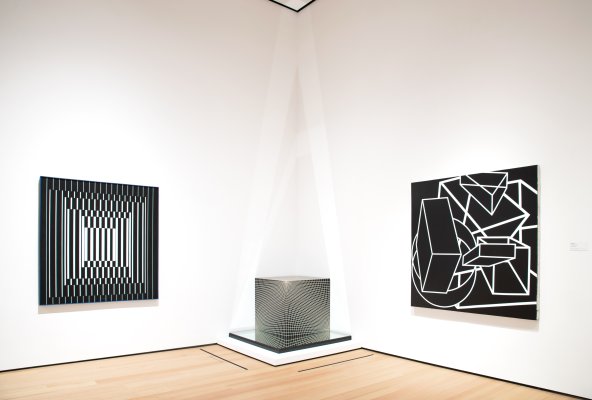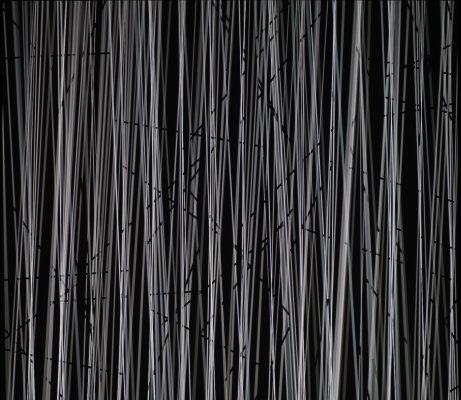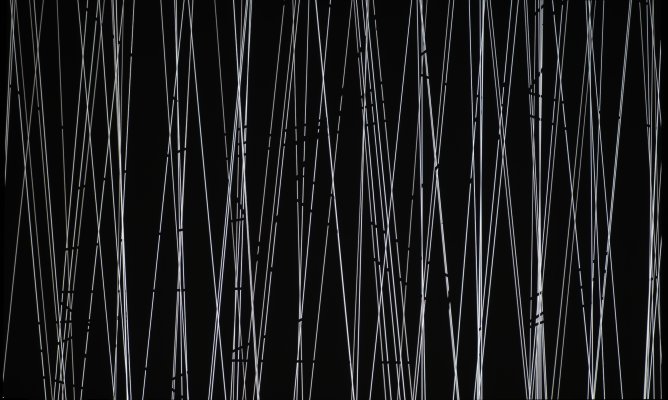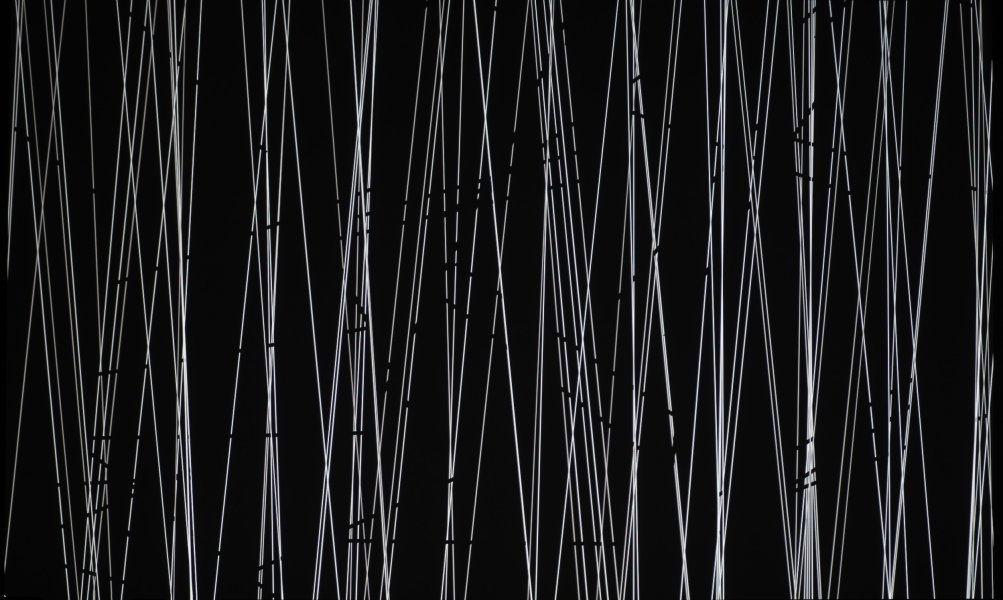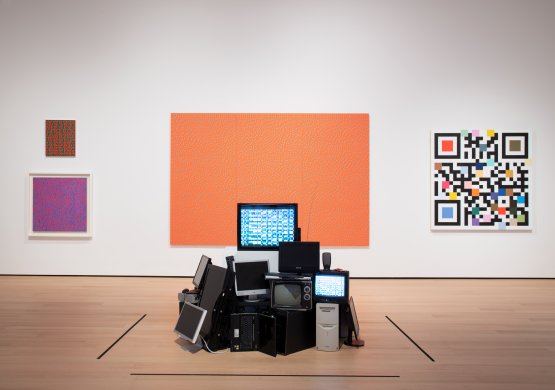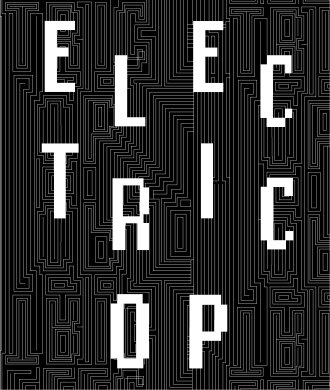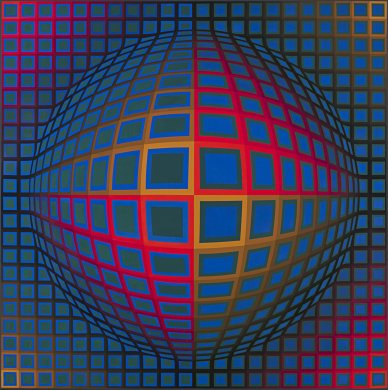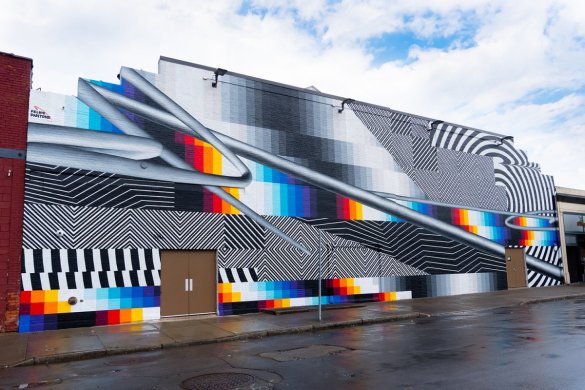By Casey Reas
I’m standing in front of Bridget Riley’s Polarity, 1964, at the Los Angeles County Museum of Art. My vision is haywire, lines on the canvas vibrate with energy, nothing is stable. It’s the strongest sense of visual interruption I’ve ever experienced standing in front of a painting. It’s intense. When I’m across the room, this image vibrates, but when I’m a few feet away, my entire visual system glitches and I’m completely disoriented. It feels great.
I’m sitting in the theater at REDCAT in Los Angeles. My vision is under assault as new frames from Lillian F. Schwartz’s UFOs, 1971, hit my eyes twenty-four times each second. Three circles orbit the center of the frame. They change color so quickly they vibrate in and out, and I can’t tell the difference between what I’m seeing and the ghosts of what I was seeing a moment ago. The space between then and now has collapsed. Each image is minimal, but the complexity in time is outside of the threshold of perception. This is a vibrant and overwhelming experience. It’s wonderful.
I’m at the Palm Spring Art Museum focused on Cuatro Modulaciones, 1969, by Jesús Rafael Soto. The surface of the sculpture is divided into a three by three grid. Each grid unit has four squares raised off the surface a few inches. The background of the central grid units is a dense field of vertical lines. As I move a little left and right naturally as I stand, the edges of the squares intersect with the lines underneath to create a buzzing in my brain. It’s so minimal and so satisfying.
These three artworks—a painting, a film, and a sculpture—activate my vision (and my entire self) in unexpected ways. They engage me completely, with a focus on my eyes, in a way I have never experienced. In the 1960s, artists working within this emerging space were thrust into the curatorial box of “Op art.” The groups of artists included in the many Op art exhibitions in the 1960s were born from 1900 through the 1930s.
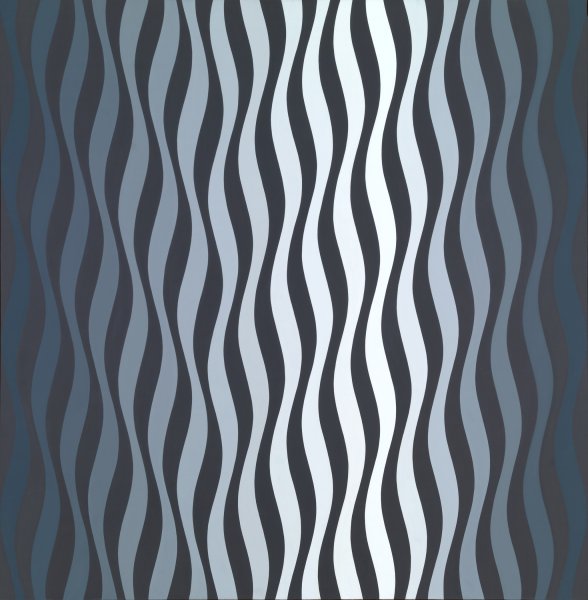
These are mostly artists who were trained as painters working with realism. For example, in the 2023 exhibition Bridget Riley Drawings: From the Artist’s Studio, we see early figurative portraits created by Bridget Riley before her personal transition into hard-edge abstraction. This is a familiar story. These artists were pioneers in abstraction with roots in prior ways of seeing. Together, these artists created a new vision, a new form of visual art. As they transitioned their work, many artists continued to work with their original medium, paint on canvas.
Since then, new generations of artists have continued the exploration, extending the paths started by the Op art pioneers away from paint and into code. Through code, artists can work fluidly with systems, motion, growth, change, response, and interactivity to push ideas beyond the material constraints of more traditional media. Right now, in 2023, there’s strong energy around work that people are calling “generative art,” and many contemporary artists working with generative art are the offspring of the Op art pioneers. Generative art started long before Op art and many Op art painters were generative artists.
There are two general approaches to defining generative art. The first is grounded in materials. Was the artwork created with computer code? The second is more conceptual: was the artist working with ideas related to systems, rules, instructions, and algorithms? Artists can choose to work with computers to create systems, or they can work with any media. The most minimal definition of generative art is, “The artist creates a system; the system creates the art.” Following this definition, computers and code are not needed to create generative art. Generative art is a way of thinking; it’s not tied to any material or technology. This is the definition that I prefer, as it allows art created with code to be in dialogue with thousands of years of art history, rather than only reaching back to the first artworks created with digital computers in the 1960s. As the conceptual artist Sol LeWitt wrote in 1967, “The idea becomes a machine that makes the art.”
With this more expansive definition of generative art, much of the history of Op art connects to what artists are creating with code today. In my opinion, many Op artists (and painters from that era in general) were operating as generative artists prior to and concurrently with artists working with computers. As one example, the French painter François Morellet created Random Distribution of 40,000 Squares Using the Odd and Even Numbers of a Telephone Directory, 50% Blue, 50% Red. As the title of the painting informs the viewer, there’s a grid of 200 × 200 units on the painting and each is colored red or blue based on the last digit of sequential phone numbers in a telephone book. A number ending in an odd digit is colored red and an even digit is colored blue. This clearly programmed artwork is representative of the strategy of working with chance operations that surrender elements of creation to actions and other things—including databases of numbers—outside of the artist’s own biases.
For over a decade, I’ve researched Op artists and other artists of that generation as examples of pre-computational generative artists. This work was inspired by Jean Tinguely’s Méta-Malevitch kinetic sculpture from 1954. By attaching a motor to a set of shapes, Tinguely created an artwork that echoed the work of Kazimir Malevich but was generating new compositions through its constant motion. Influenced by this idea, in 2004 I created Software Structures, a commission from the Whitney Museum of American Art to explore the work of Sol LeWitt through the lens of code. My CENTURY exhibition at [DAM] Berlin in 2012 debuted work I created in homage to Bridget Riley, François Morellet (I have my favorites!), and many others. I began to create subjective software homages to iconic work to understand these artists, to look closer, and to explore deeper. I consider this active research into art history—writing new code to decipher artworks from the past.
Most recently, I worked from Bois-tiges de fer by Jesús Rafael Soto (a work in the AKG’s collection). In this artwork, delicate, curved steel rods hang by thin threads; they move gently in front of a painted field of vertical lines. As the rods move, they create a vibration as the silhouette of the rod intersects with the lines. For this new work, METASOTO, 2022, I pushed further than my past homages; the work departs significantly from the original kinetic sculpture. METASOTO is a series of sixty-four artworks, each with different speeds and densities of lines determined by generating random numbers within the code. Through working in this way, I’m creating conversations between the past and present.
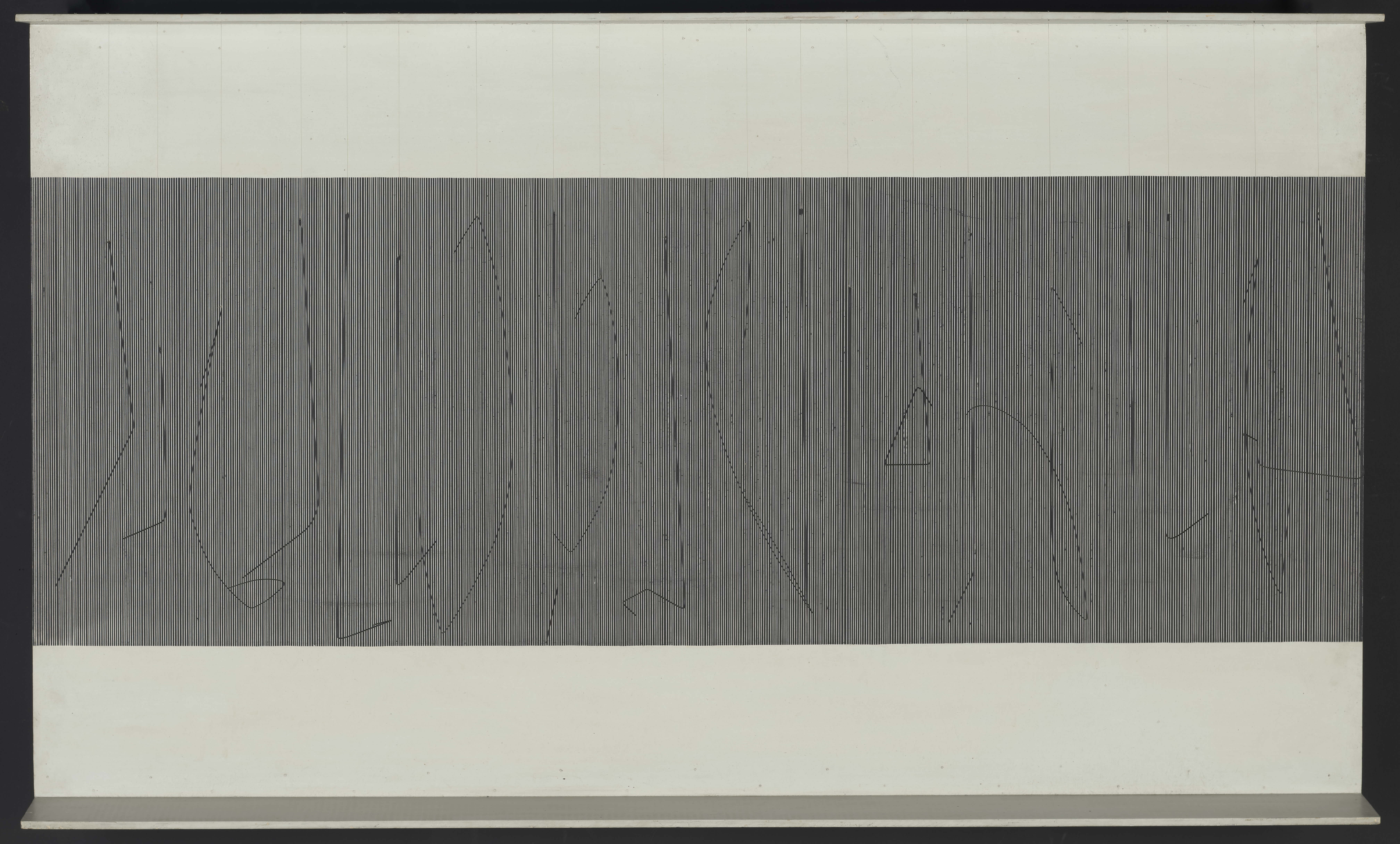
Unlike Soto’s work, which relies on the movement in the air, there’s no gravity or air in a digital simulation. This creates an interesting condition to think about motion outside of the laws of physics, rather than to simulate them. It opens new ways to imagine movement. For METASOTO, I combined sine waves to create a constant, rhythmic motion that is related to, but unique from the motion channeled in Soto’s work. Like all of my work, I start by making diagrams on paper, then sketching with the Processing language that I co-created with Ben Fry. For METASOTO, I ported that code to the p5.js language, a sibling language to Processing created by Lauren Lee McCarthy, so I can run the work within a web browser. Within the browser, the work isn’t locked inside an institution, it can be viewed anytime by anyone with a network connection. Placing work online is a contemporary form of public art. This connects to the history of Op art, it follows the priority of many of the pioneering artists like Soto, Victor Vasarely, and Yaacov Agam to have their work available in public space, to be enjoyed by everyone.
Op art, as contemporary art in the 1960s, started with painting, drawing, and sculpture, but it certainly didn’t end there. Looking at generative art created with code from the last few decades, we see the histories of kinetic art, concrete art, abstraction, painting, drawing, performance, and conceptual art converge into new visual systems. Artists working with software have unlocked new dimensions and have opened new paths for Op art. A unique thing about working with code is the opportunities for change over time: the work can be different each time it’s seen, moment to moment or over decades.
Since the formulation of Op art in the 1960s, the world has changed and art has changed with it. However, the legacy of Op art is clear today, with the next generation of artists consciously and unconsciously building on its legacy.
Casey Reas is a professor at UCLA’s Design Media Arts program and a computational artist whose works are in collections including MoMA, the Centre Georges Pompidou, and the Victoria and Albert Museum. In 2021 he founded Feral File, an online gallery for editioned digital art. He is also renowned as the co-developer of Processing, a widely used programming language for creating visual art. Reas's work is featured in the exhibition Electric Op.
